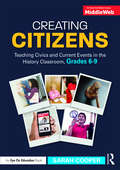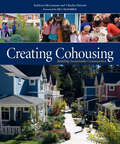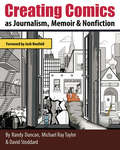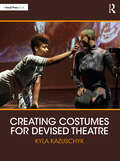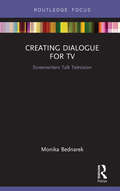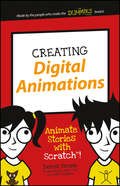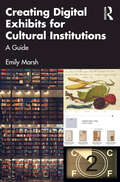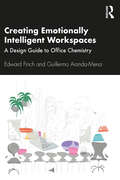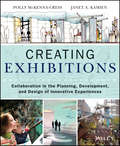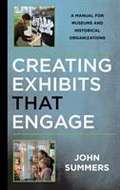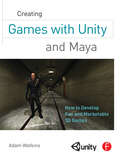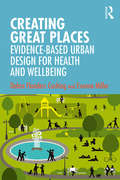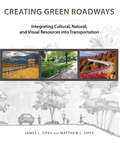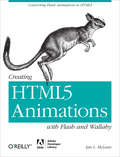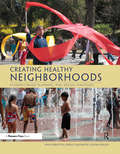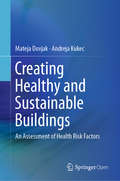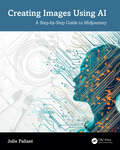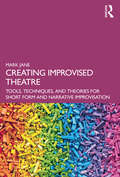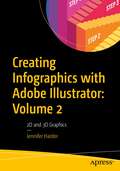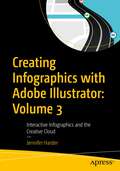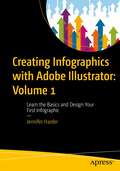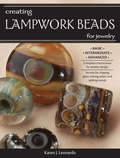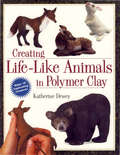- Table View
- List View
Creating Citizens: Teaching Civics and Current Events in the History Classroom, Grades 6–9
by Sarah CooperEngage students in meaningful civic learning and encourage them to become active and informed citizens. With this essential book, co-published by Routledge and MiddleWeb, you will gain a variety of practical strategies for teaching civics and current events to your middle school students. Author and expert teacher Sarah Cooper takes you into her school and shares her classroom-tested methods and tools.Topics include: Fitting current events into an already-packed history curriculum Staying nonpartisan and fostering balanced discussions Helping students find their stake in the news Teaching civic literacy through primary sources, then and now Encouraging students to invest in analytical writing Fostering student ownership of our classrooms through discussion and debate Cultivating citizenship through empathy and community engagement Throughout the book, you’ll find student examples, handouts, and rubrics, so that you can easily implement the ideas in your own classroom. By getting your students to think critically about current events, you will help them become passionate writers, thinkers, and involved citizens.
Creating Cohousing
by Kathryn Mccamant Charles DurrettCohousing balances privacy and independence with the benefits of living in community. This completely revised and updated third edition of the "cohousing bible" invites readers into these sustainable neighborhoods, and provides practical tools for developing their own.
Creating Comics as Journalism, Memoir and Nonfiction
by Randy Duncan Michael Ray Taylor David StoddardThis book provides student journalists, artists, designers, creative writers and web producers with the tools and techniques they need to tell nonfiction stories visually and graphically. Weaving together history, theory, and practical advice, seasoned nonfiction comics professors and scholars Randy Duncan, Michael Ray Taylor and David Stoddard present a hands-on approach to teach readers from a range of backgrounds how to develop and create a graphic nonfiction story from start to finish. The book offers guidance on: -how to find stories and make use of appropriate facts and visuals; -nonfiction narrative techniques; -artist's tools and techniques; -print, digital, and multimedia production; -legal and ethical considerations. Interviews with well-known nonfiction comics creators and editors discuss best practices and offer readers inspiration to begin creating their own work, and exercises at the end of each chapter encourage students to hone their skills.
Creating Costumes for Devised Theatre
by Kyla KazuschykCreating Costumes for Devised Theatre combines perspectives from a variety of theatre practitioners to guide artists through the journey of creating costumes for devised work. Devised theatre can take a number of different forms, and it can be a challenge for the costume department to plan, organize, and assemble things for performers to wear while the entire shape of the piece is constantly changing. This book provides practical resources to guide the theatre artist through the journey of designing costumes as the characters are created. It addresses a wide range of questions, including how to adapt traditional methods of costume design to non-traditional practices, how to effectively collaborate with a team, and how to adapt costume technology practices to meet the needs of devising. Stories and photographs from performers, designers, technicians, directors, writers, educators, students, and activists working in the realm of devised theatre around the world are contextualized through the author's own involvement in unscripted, partially scripted, and otherwise dynamic drama, dance, and physical theatre to offer tangible solutions to streamline costume design and construction processes. This book is an invaluable guide for both experienced and novice costume designers, costume technicians, students, teachers, directors, managers, and theatre artists who exist in the spaces where all these roles overlap.
Creating Dialogue for TV: Screenwriters Talk Television (Routledge Studies in Media Theory and Practice)
by Monika BednarekAs entertaining as it is enlightening, Creating Dialogue for TV: Screenwriters Talk Television presents interviews with five Hollywood professionals who talk about all things related to dialogue – from naturalistic style to the building of characters to swearing and dialect. Screenwriters/showrunners David Mandel (Curb Your Enthusiasm, Veep), Jane Espenson (Buffy, Battlestar Galactica, Once Upon a Time), Robert Berens (Supernatural), Sheila Lawrence (Gilmore Girls, Ugly Betty, The Marvelous Mrs Maisel), and Doris Egan (Tru Calling, House, Reign) field a linguist’s inquiries about the craft of writing dialogue. This book is for anyone who has ever wondered what creative processes and attitudes lie behind the words they encounter when tuning into their favourite television show. It provides direct insights into Hollywood writers’ knowledge and opinions of how language is used in television narratives, and in doing so shows how language awareness, attitudes and the craft of using words are utilised to create popular TV series. The book will appeal to students and teachers in screenwriting, creative writing and linguistics as well as lay readers.
Creating Digital Animations
by Derek BreenThe easy way to start animating today! Creating Digital Animations is your ticket to learning animation! Learn how to animate your very own characters using Scratch--the free multimedia tool that lets you create interactive stories, games, and animations. Designed specifically for kids aged seven and up, this easy-to-follow, full-color guide introduces you to important game design concepts through three simple projects. Step-by-step instructions walk you through the four major phases of animation design, showing you how to turn your idea into a real animation with sound effects and more! You'll work just like the pros as you sketch out your main idea, add your own details, and develop a complete, workable character from scratch. If you're curious about coding, animation is the perfect place to start exploring. The Scratch platform doesn't require an actual programming language, but it gets you used to thinking like a programmer while you develop your very own animation. Short on rules but big on fun, this book is your friendly animation coach to get you started on the right foot. Use stick figures to design your characters' 'bones' Flesh out your design and animate movements Create scenes and background locations Add sound to take your animation to the next level Animation is fun! Building your own characters is exciting! And putting the finishing touches on your animation project shows you just how much you can learn while you play. Coding is a valuable skill that will serve you throughout school and beyond, and this book teaches you the basics in a way that leaves you hungry for more. Where will you take your new animation skills next? Creating Digital Animations takes you on the first steps of your journey to wherever you want to go!
Creating Digital Exhibits for Cultural Institutions: A Guide
by Emily MarshCreating Digital Exhibits for Cultural Institutions will show you how to create digital exhibits and experiences for your users that will be informative, accessible and engaging. Illustrated with real-world examples of digital exhibits from a range of GLAMs, the book addresses the many analytical aspects and practical considerations involved in the creation of such exhibits. It will support you as you go about: analyzing content to find hidden themes, applying principles from the museum exhibit literature, placing your content within internal and external information ecosystems, selecting exhibit software, and finding ways to recognize and use your own creativity. Demonstrating that an exhibit provides a useful and creative connecting point where your content, your organization, and your audience can meet, the book also demonstrates that such exhibits can provide a way to revisit difficult and painful material in a way that includes frank and enlightened analyses of issues such as racism, colonialism, sexism, class, and LGBTQI+ issues. Creating Digital Exhibits for Cultural Institutions is an essential resource for librarians, archivists, and other cultural heritage professionals who want to promote their institution’s digital content to the widest possible audience. Academics and students working in the fields of library and information science, museum studies and digital humanities will also find much to interest them within the pages of this book.
Creating Emotionally Intelligent Workspaces: A Design Guide to Office Chemistry
by Edward Finch Guillermo Aranda-MenaEmotions in the workplace have until recently been seen simply as a distraction. We often think of work as rational, logical and non-emotional. But organisations are waking up to the key role of emotions and affect at work. Emotions influence how we make decisions, how we relate with one another and how we make sense of our surroundings. Whilst organisations are slowly embracing the pivotal role of emotions, designers and managers of workplaces have been struggling to keep up. New insights from hard sciences such as neuropsychology are presenting a radically different interpretation of emotions. Yet workplace designers and facilities managers still rely on measuring non-specific states such as satisfaction and stress. In this book we attempt to capture modern-day interpretations of emotion, looking at emotion in terms of transactions and processes rather than simple cause and effect. We entertain the idea of an ‘emotionally intelligent building’ as an alternative to the much-hyped intelligent building. The assertion is that we should create environments that are emotionally intelligent. Rather than focusing on the aptitudes or shortcomings of individuals at work, we should place closer attention on the office environment. It’s not that we are emotionally disabled – it’s the environment that disables us! The ability of you and me to interpret, control and express emotions may not simply be a result of our own make-up. A radically different outlook considers how our workspace and workplace debilitates or enables our emotional understanding. In the modern workplace there are many innovations that can undermine our emotional intelligence, such poorly implemented hot-desking or lean environments. Contrariwise there are key innovations such as Activity Based Working (ABW) that have the potential to enhance our emotional state. Through a series of unique case studies from around the world, we investigate key concepts that can be used by designers and facilities managers alike. No longer should designers be asked to incorporate emotional elements as intangible un-costed ‘add-ons’. This book provides a shot in the arm for workplace design professionals, pointing to a new way of thinking based on the emotional intelligence of the workplace.
Creating Exhibitions
by Polly Mckenna-Cress Janet Kamien"This is a must-read for the nervous novice as well as the world-weary veteran. The book guides you through every aspect of exhibit making, from concept to completion. The say the devil is in the details, but so is the divine. This carefully crafted tome helps you to avoid the pitfalls in the process, so you can have fun creating something inspirational. It perfectly supports the dictum--if you don't have fun making an exhibit, the visitor won't have fun using it." --Jeff Hoke, Senior Exhibit Designer at Monterey Bay Aquarium and Author of The Museum of Lost WonderStructured around the key phases of the exhibition design process, this guide offers complete coverage of the tools and processes required to develop successful exhibitions. Intended to appeal to the broad range of stakeholders in any exhibition design process, the book offers this critical information in the context of a collaborative process intended to drive innovation for exhibition design. It is indispensable reading for students and professionals in exhibit design, graphic design, environmental design, industrial design, interior design, and architecture.
Creating Exhibits That Engage: A Manual For Museums And Historical Organizations (American Association For State And Local History)
by John SummersCreating Exhibits that Engage: A Manual for Museums and Historical Organizations is a concise, useful guide to developing effective and memorable museum exhibits. The book is full of information, guidelines, tips, and concrete examples drawn from the author’s years of experience as a curator and exhibit developer in the United States and Canada. Is this your first exhibit project? You will find step-by-step instructions, useful advice and plenty of examples. Are you a small museum or local historical society looking to improve your exhibits? <p><p> This book will take you through how to define your audience, develop a big idea, write the text, manage the budget, design the graphics, arrange the gallery, select artifacts, and fabricate, install and evaluate the exhibit. Are you a museum studies student wanting to learn about the theory and practice of exhibit development? This book combines both and includes references to works by noted authors in the field. Written in a clear and accessible style, Creating Exhibits that Engage offers checklists of key points at the end of each chapter, a glossary of specialized terms, and photographs, drawings and charts illustrating key concepts and techniques.
Creating Experimental Documentary Films: Theory and Practice Beyond Convention
by Pablo FrasconiThis book explores the continued development and practice of experimental documentary film making with evolving trends in still photography, visual arts, journalism, installation art, docudrama, interactive media, music, poetry, and creative nonfiction. Through examples, observations, analyses, and exercises, readers will gain an understanding of the traditional principles of documentary and simultaneously challenge those conventions.While exploring the responsibilities of a documentary director to be fair and objective, the book weaves through arguments around truth and propaganda and offers practical lessons about how to create hybrid forms of documentary films. Written by a documentary filmmaker with decades of experience, the text provides a comprehensive overview of how documentary narratives are written and created in the research, pre-production, production and post-production phases. New, inclusive audiences and methods of distribution, interactivity, and immersion are also introduced as part of the changing landscape of the documentary genre.This book is designed for students who are approaching documentary for the first time as well as documentary filmmakers who are searching for new approaches, new subject matter, and languages of cinematic expression.
Creating Games with Unity and Maya: How to Develop Fun and Marketable 3D Games
by Adam WatkinsUnity brings you ever closer to the "author once, deploy anywhere" dream. With its multiplatform capabilities, you can target desktop, web, mobile devices, and consoles using a single development engine. Little wonder that Unity has quickly become the #1 game engine out there. Mastering Unity is absolutely essential in an increasingly competitive games market where agility is expected, yet until now practical tutorials were nearly impossible to find. Creating Games with Unity and Maya gives you with an end-to-end solution for Unity game development with Maya. Written by a twelve-year veteran of the 3D animation and games industry and professor of 3D animation, this book takes you step-by-step through the process of developing an entire game from scratch-including coding, art, production, and deployment. This accessible guide provides a "non-programmer" entry point to the world of game creation. Aspiring developers with little or no coding experience will learn character development in Maya, scripts, GUI interface, and first- and third-person interactions.
Creating Great Places: Evidence-based Urban Design for Health and Wellbeing
by Debra Flanders Cushing Evonne MillerThis book provides a bold vision and roadmap for creating great places. Imagining and designing urban environments where all people thrive is an extraordinary task, and in this compelling narrative, Cushing and Miller remind us that theory is a powerful starting point. Drawing on international research, illustrated case studies, personal experiences, as well as fascinating examples from history and pop culture, this practical book provides the reader with inspiration, guidance and tools. The first section outlines six critical theories for contemporary urban design - affordance, prospect-refuge, personal space, sense of place/genius loci, place attachment, and biophilic design. The second section, using their innovative ‘theory-storming’ process, demonstrates how designers can create great places that are inclusive, sustainable, and salutogenic. Creating Great Places is an insightful, compelling, and evidence-based resource for readers who want to design urban environments that inspire, excite, and positively transform people’s lives.
Creating Green Roadways: Integrating Cultural, Natural, and Visual Resources into Transportation
by James L. Sipes Matthew L. SipesRoads and parking lots in the United States cover more ground than the entire state of Georgia. And while proponents of sustainable transit often focus on getting people off the roads, they will remain at the heart of our transportation systems for the foreseeable future. In Creating Green Roadways, James and Matthew Sipes demonstrate that roads don't have to be the enemy of sustainability: they can be designed to minimally impact the environment while improving quality of life. The authors examine traditional, utilitarian methods of transportation planning that have resulted in a host of negative impacts: from urban sprawl and congestion to loss of community identity and excess air and water pollution. They offer a better approach--one that blends form and function. Creating Green Roadways covers topics including transportation policy, the basics of green road design, including an examination of complete streets, public involvement, road ecology, and the economics of sustainable roads. Case studies from metropolitan, suburban, and rural transportation projects around the country, along with numerous photographs, illustrate what makes a project successful. The need for this information has never been greater, as more than thirty percent of America's major roads are in poor or mediocre condition, more than a quarter of the nation's bridges are structurally deficient or functionally obsolete, and congestion in communities of all sizes has never been worse. Creating Green Roadways offers a practical strategy for rethinking how we design, plan, and maintain our transportation infrastructure.
Creating HDR Photos: The Complete Guide to High Dynamic Range Photography
by Harold DavisSince the days of the first photographs, artists have used various techniques to extend the range of lights and darks in their photos. Photographic masters such as Ansel Adams and Edward Weston spent countless hours burning and dodging their prints to create images with extended dynamic range. With the advent of digital photography, new horizons in extending dynamic range are possible. HDR techniques now make it easy to extend the dynamic range of an image well beyond the capability of the human eye.In Creating HDR Photos, bestselling author Harold Davis covers the complete HDR workflow, from choosing the subjects that work best for HDR through processing RAW files to unlock the dynamic power of HDR. You'll learn how to photograph multiple exposures and blend them into a single HDR image using various software programs. Best of all, you will find out how to control the style of your HDR images, from subtle to hyper-real, using a range of photographic and post-processing techniques. Packed with stunning image examples, Creating HDR Photos brings this essential digital technique within every photographer's grasp.
Creating HTML5 Animations with Flash and Wallaby: Converting Flash Animations to HTML5 (Oreilly And Associate Ser.)
by Ian L. McLeanCreating standards-compliant animations for the Web just got a lot easier. With this concise guide, you’ll learn how to convert Flash animations into HTML5, using Wallaby—the experimental tool from Adobe. Wallaby makes Flash content available for devices that don't support Flash runtimes, including the iPhone and iPad.Developing HTML5 animations is time-consuming with all the coding required. This book shows you how to create compelling content for HTML5 environments with relative ease, whether you know Flash or not. After a quick introduction to simple animation building with Flash, you'll learn how Wallaby helps you convert those animations into HTML5 code.Learn how to create a simple Flash animation, using Flash Professional CS5Become familiar with the Flash Library, Stage drawing canvas, and animation TimelineTake the right approach to building a complex Flash animation for HTML5Get performance tips to optimize animations for desktops and mobile devicesUse simple JavaScript and CSS code to place the Wallaby animation in a web pageAdd interactivity to your HTML5 animation with jQuery
Creating Healthy Neighborhoods: Evidence-Based Planning and Design Strategies
by Ann Forsyth Emily Salomon Laura SmeadGood housing. Easy transit. Food access. Green spaces. Gathering places. Everybody wants to live in a healthy neighborhood. Bridging the gap between research and practice, it maps out ways for cities and towns to help their residents thrive in placed designed for living well, approaching health from every side – physical mental, and social.
Creating Healthy and Sustainable Buildings: An Assessment of Health Risk Factors
by Mateja Dovjak Andreja KukecThe open access book discusses human health and wellbeing within the context of built environments. It provides a comprehensive overview of relevant sources of literature and user complaints that clearly demonstrate the consequences of lack of attention to health in current building design and planning. Current designing of energy-efficient buildings is mainly focused on looking at energy problems and not on addressing health. Therefore, even green buildings that place environmental aspects above health issues can be uncomfortable and unhealthy, and can lead to public health problems. The authors identify many health risk factors and their parameters, and the interactions among risk factors and building design elements. They point to the need for public health specialists, engineers and planners to come together and review built environments for human wellbeing and environmental sustainability. The authors therefore present a tool for holistic decision-making processes, leading to short- and long-term benefits for people and their environment.
Creating Images Using AI: A Step-by-Step Guide to Midjourney
by Julie PallantCreating Images Using AI: A Step-by-Step Guide to Midjourney is an essential resource for professionals and others looking to harness the amazing power of AI-powered image generator programs and to ensure they keep up to date with developments in this rapidly evolving field. This comprehensive guide offers an in-depth exploration of Midjourney, one of the most respected programs available today, used by over 17 million users.The book covers the fundamentals of setting up and using Midjourney through to advanced techniques for crafting precise text- and image-based prompts to ensure high-quality images. Detailed step-by-step instructions are provided to facilitate a thorough understanding of the program, supported throughout by screenshots and examples of Midjourney image output. Included are case studies of talented artists who use Midjourney as a creative tool, with examples of their inspiring art to motivate readers. A dedicated chapter offers resources for photographers, designers, and artists to expand their skills, and to stay up to date with the latest developments in AI technology.Whether you're seeking to enhance your professional toolkit or simply explore AI as a creative outlet, this book offers the knowledge and skills to harness Midjourney’s full potential. For professionals in photography, graphic design, marketing, advertising, and education, it provides the essential tools to stay ahead in a rapidly changing industry.
Creating Improvised Theatre: Tools, Techniques, and Theories for Short Form and Narrative Improvisation
by Mark JaneCreating Improvised Theatre: Tools, Techniques, and Theories for Short Form and Narrative Improvisation is a complete guide to improvised theatre for performers and instructors. This book provides a modern view of improvised theatre based on the rapid evolution of this art form, shedding new light on classic theories as well as developing lesser known and emerging techniques, such as the Trance Mask. Instead of simply referencing classic theories, the book revisits them and places them in the context of contemporary improvisation techniques. Designed as a practical support, this guide contains over 130 exercises that allow its theories to come alive in workshops, rehearsals, and performance. The book is divided into four sections: Nuts and bolts: The fundamental tools of improvisation to explore how to be spontaneously creative, build with your partner, and learn from masks to discover your scene instant by instant. Short form: Techniques for scene work and short form performance, including how to get the most out of a scene, remain connected to the relational stakes, provoke change (physical, status, and emotional), and maintain a playful attitude. Narrative improvisation: Theories to help navigate long form narrative-based shows with "narrative waypoints," generate variety, develop protagonists, work on genres, and manipulate creative transitions. The bits box: Advice for warming-up before a rehearsal or a show with a collection of useful games. Written to inspire creativity and provide the tools to develop innovative improvised shows and experiences, Creating Improvised Theatre is an invaluable source book for anyone interested in the art of improvised theatre, whether a beginning student or experienced performer.
Creating Infographics with Adobe Illustrator: 2D and 3D Graphics
by Jennifer HarderThis full-color book will teach you how to use Adobe Illustrator's various tools to create infographics, as well as basic page layouts for them. It focuses on Illustrator’s powerful graphing tools and 2D and 3D effects. How can an infographic or graph be altered and adapted to appear more engaging and still display your data accurately? What additional effects can be used on your infographic to produce the results you envision? In this second volume of Creating Infographics with Adobe Illustrator, you will learn the answers to all these questions. Author Jennifer Harder will walk you through creating basic infographics in Illustrator using Illustrator tools such as Graphing Tools as well as how to create 2D effects and 3D shapes with their related materials, including Symbols. Upon completing this volume, you will have an appreciation for how easy it is to design an infographic or graph to display your data and discover how rudimentary shapes and colors can be altered using patterns, as well as 2D and 3D effects, to enhance readability while conveying meaning to your audience. You will be able to use this knowledge to create your own infographics using Illustrator’s wide array of tools. What You Will Learn Use Illustrator’s Graphing Tools to create and modify basic charts or graphsWork with popular 2D effects to enhance your design in IllustratorCreate 3D Shapes using Materials and Symbols and modify your 3D GraphsExplore basic Image Trace and Perspective options in Illustrator Who This Book Is For Beginner-level designers and others who are interested in learning the process of creating infographics for their company, the classroom, for data visualization, an article in a magazine, or a webpage.
Creating Infographics with Adobe Illustrator: Interactive Infographics and the Creative Cloud
by Jennifer HarderThis full-color book, the third of three volumes, focuses on Adobe Illustrator’s SVG interactivity tools. How can an infographic be made more interactive for an audience? What additional Illustrator tools and Adobe applications can be used to enhance your infographic layout? In this final volume of Creating Infographics with Adobe Illustrator, you will learn the answers to all these questions. Author Jennifer Harder will walk you through creating basic infographics in Illustrator using Illustrator tools for creating SVG files, known as Scalable Vector Graphics, for basic Interactivity on a web page. Then you will review layouts in other Adobe Applications in relation to their connectivity with Illustrator. Upon completing this volume, you will have a thorough understanding of how to design an infographic with basic interactivity for a web page, and how this can improve visualization and convey meaning to your audience. Moreover, you will be able to use this knowledge to create your own infographics using Illustrator’s wide array of tools. What You Will Learn Discover how to apply interactivity to an infographicGain insight into different infographic layouts and how to finalize your project with your clientExplore other Adobe Creative Cloud applications that may assist you in the future as you create your infographics Who This Book Is For Beginner-level designers and others who are interested in learning the process of creating infographics for their company, the classroom, for, an article in a magazine, or adding interactivity to webpage.
Creating Infographics with Adobe Illustrator: Learn the Basics and Design Your First Infographic
by Jennifer HarderThis full-color book will teach you how to use Adobe Illustrator's various tools to create infographics, as well as basic page layouts for them. This is the first of three volumes which will cover all the fundamentals of Illustrator, an industry standard application used by graphic designers and marketing and communication teams. How is an infographic different from a logo or any other illustration? What additional thought processes, skills, or software tools should be utilized to create an infographic? In this first volume of Illustrator Basics, you will learn the answers to all these questions. Author Jennifer Harder will walk you through creating basic infographics in Illustrator using Basic Shape tools, Pen Tools, Type Tools, and Symbols. Upon completing this volume, you will have an appreciation for how easy it is to design an infographic and discover how rudimentary shapes and colors can affect readability while conveying meaning to your audience. You will be able to use this knowledge to create your own infographics using Illustrator’s wide array of tools. Who This Book Is For Discover the tools within Illustrator that are ideal for creating basic infographicsDevelop a logo based upon a scanned sketchGain an understanding of different infographic layouts and the process of reviewing them with your client Who This Book Is For Beginner-level designers and others who are interested in learning the process of creating infographics for their company, the classroom, for a visual resume, an article in a magazine, or a webpage.
Creating Lampwork Beads for Jewelry
by Karen LeonardoCREATE - DESIGN - WEAR From tiny glass beads and pendants to rings and necklaces, Creating Lampwork Beads for Jewelry teaches you how to create them all. Lampwork artist Karen J. Leonardo and her network of fellow artisans share their secrets for creating stunningly beautiful lampwork beads. In addition, these talented artists give you complete instructions for incorporating the beads into your own artistic jewelry pieces. Ideal for beginning, intermediate and advanced lampwork artists, Creating Lampwork Beads for Jewelry features: Guidance and tips for setting up your studio and selecting the proper tools Detailed instructions with step-by-step photos for creating 16 different lampwork beads 14 jewelry designs to incorporate your beads into necklaces, bracelets, rings, earrings and pins
Creating Life-Like Animals in Polymer Clay
by Katherine DeweyEnchanting, exquisitely detailed and full of personality, Katherine Dewey's animal sculptures delight all who see them. With the friendly medium of polymer clay and the step-by-step instructions in this book, you can achieve the same magical results! Inside, Katherine leads you through then utterly charming projects, such as a sweet little bluebird, a basset hound and a white-tailed fawn. And that's just the start! The "Making Changes" chapter will help you create your own original animal creations by changing poses, making realistic bases, and even modeling your animals to look like bronze, fade and other materials.
